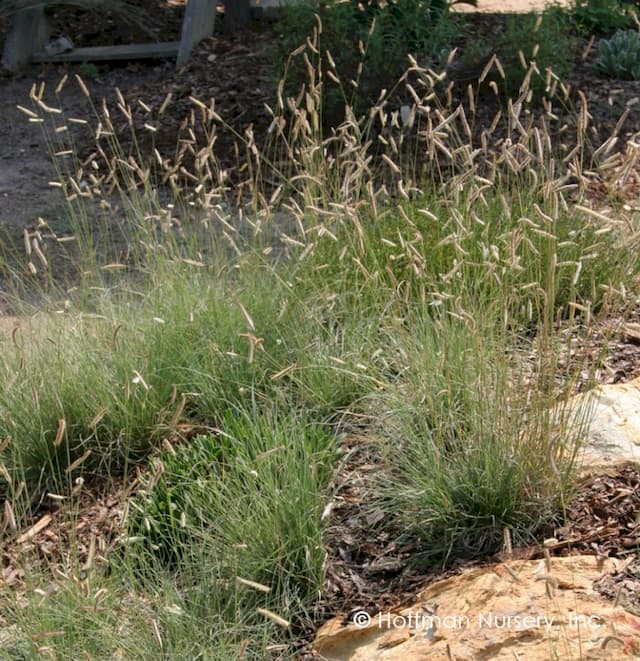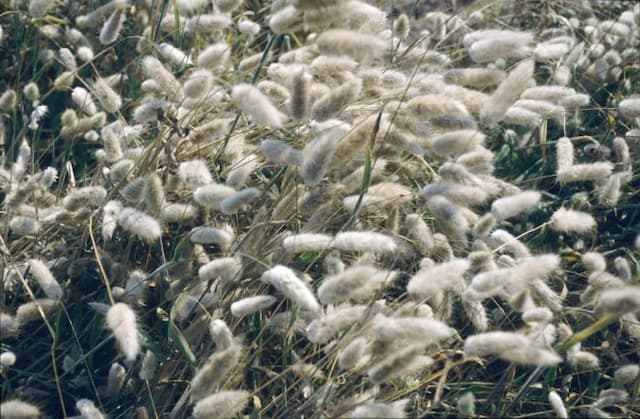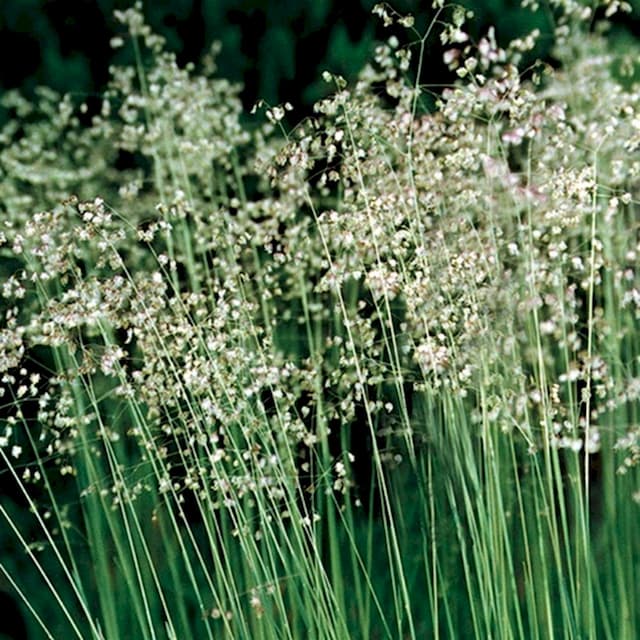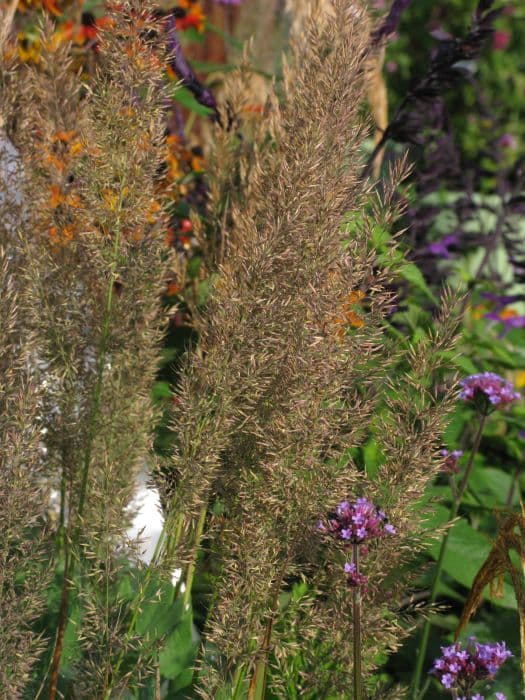Feather grass Stipa calamagrostis 'Allgäu'

ABOUT
The plant known as Stipa calamagrostis 'Allgäu', often referred to by its common name, the feather grass, presents an elegant and graceful appearance. It features fine, narrow leaves that create a dense, tussock-like clump. The foliage is typically green, offering a lush backdrop for the distinctive feathery blooms. These blooms are notable for their airy and delicate texture, which resemble soft plumes or tails that are carried aloft on slender stems. The flowers bear a light, silvery to golden hue, catching the light and adding a shimmering effect to the landscape. As the seasons change, the plant's foliage may transform into a golden color, providing visual interest throughout different times of the year.
About this plant
 Names
NamesFamily
Poaceae.
Synonyms
Feather Grass, Pheasant's Tail Grass, Tussock Grass.
Common names
Stipa calamagrostis 'Allgäu'.
 Toxicity
ToxicityTo humans
Feather grass, including the 'Allgäu' variety of Stipa calamagrostis, is not known to be toxic to humans. Therefore, there are typically no symptoms associated with poisoning from this plant, as it is generally considered non-poisonous. Ingesting any part of this plant should not cause any toxic effects. However, it's always important to exercise caution and avoid eating plants not meant for consumption as they can cause mechanical irritation or be mistaken for other harmful species.
To pets
Feather grass, including the 'Allgäu' variety of Stipa calamagrostis, is not known to be toxic to pets. Generally, there are no known toxic effects or symptoms of poisoning in pets from ingesting this plant. The ingestion of plant material could possibly cause mild stomach upset in some pets due to mechanical irritation or if they are not used to digesting plant matter, but feather grass is not recognized for having poisonous attributes.
 Characteristics
CharacteristicsLife cycle
Perennials
Foliage type
Deciduous
Color of leaves
Green
Flower color
Silver
Height
2-3 feet (60-90 cm)
Spread
1-2 feet (30-60 cm)
Plant type
Grass
Hardiness zones
5
Native area
Europe
Benefits
 General Benefits
General Benefits- Ornamental Appeal: Adds aesthetic value to gardens with its feather-like flowers and fine, arching foliage.
- Drought Tolerance: Once established, it can survive with little water, making it suitable for xeriscaping and water-wise gardens.
- Low Maintenance: Requires minimal care beyond the occasional pruning to keep it looking tidy.
- Attracts Wildlife: Provides food and habitat for birds and insects, promoting biodiversity.
- Soil Erosion Control: The dense growth habit and root system helps to stabilize soil, particularly in windy or sloped areas.
- Year-Round Interest: Offers visual interest throughout all seasons, including wintertime when the golden inflorescences stand out against the landscape.
- Adaptability: Can grow in a variety of soil types, provided they are well-draining.
- Non-Invasive: Unlike some ornamental grasses, it typically does not spread aggressively, making it easier to manage in a garden setting.
 Medical Properties
Medical PropertiesThis plant is not used for medical purposes.
 Air-purifying Qualities
Air-purifying QualitiesThis plant is not specifically known for air purifying qualities.
 Other Uses
Other Uses- Acoustic Improvement: Silver feather grass is used in landscaping to improve sound insulation due to its dense foliage which can absorb sound vibrations.
- Erosion Control: Its deep root system helps stabilize soil and prevent erosion on slopes and hillsides.
- Habitat Creation: It provides a habitat for wildlife, offering shelter and nesting materials for birds and small mammals.
- Winter Interest: The plant retains its form and seed heads during winter, adding visual interest in otherwise barren gardens.
- Textile Dyeing: The plant's natural colors can be used to dye fabrics in shades of brown and green.
- Thatching: The long, durable leaves of silver feather grass can be used as a traditional roofing material for small structures.
- Floral Arrangements: Silver feather grass is used in dried flower arrangements and bouquets for its aesthetic appeal.
- Artistic Inspiration: The wispy and flowing nature of the grass is often used by artists and photographers as a subject or backdrop for their work.
- Biomass Production: It can be grown as a biomass crop for bioenergy purposes due to its rapid growth.
- Crafts and Decorations: Dried stems and leaves can be incorporated into handmade paper, wreaths, or other crafts for a natural touch.
Interesting Facts
 Feng Shui
Feng ShuiThe Feather Grass is not used in Feng Shui practice.
 Zodiac Sign Compitability
Zodiac Sign CompitabilityThe Feather Grass is not used in astrology practice.
 Plant Symbolism
Plant Symbolism- Resilience: Stipa calamagrostis, commonly known as feather grass, has a hardy and tough nature, symbolizing the ability to withstand challenging conditions and bounce back.
- Elegance: The delicate and graceful form of feather grass stands for natural beauty and a sense of finesse.
- Simplicity: Feather grass, with its minimalistic appearance, often represents the beauty in simplicity and the importance of focusing on the essentials.
- Freedom: The way feather grass sways in the wind can symbolize a sense of freedom and the idea of going with the flow of life.
- Growth: As a plant that can thrive in poor soils, feather grass embodies growth and the idea of prospering despite adversity.
 Water
WaterSilver Feather grass, commonly known as Stipa calamagrostis 'Allgäu', should be watered deeply but infrequently to mimic its preference for a drier habitat. Typically, watering once every week or two, providing about 1 to 1.5 inches of water each time should be sufficient, depending on local weather conditions such as heat and wind which might necessitate more frequent watering. During the growing season, ensure that the soil is moist but not waterlogged. In winter, water sparingly as the plant is dormant and excess water can lead to root rot. Adjust watering to less than half a gallon per plant each time if you're experiencing particularly wet or humid conditions.
 Light
LightSilver Feather grass thrives best in full sun where it can receive at least six hours of direct sunlight every day. It can tolerate partial shade, but its growth may not be as robust. The ideal spot for the plant is in an area with clear exposure to the sky, relatively open to ensure it gets uninterrupted sunlight. Avoid deeply shaded areas which can lead to weak growth and less vigorous plumes.
 Temperature
TemperatureSilver Feather grass prefers moderate to warm temperatures and is hardy in a range that typically spans from 40°F to 80°F. While it can survive temperatures just below freezing, prolonged exposure to temperatures under 20°F may damage the plant. The ideal temperature for thriving growth is between 50°F and 75°F, which supports vigorous foliage and plume production.
 Pruning
PruningTo encourage healthy growth and maintain an attractive shape, prune Silver Feather grass in late winter or early spring before new growth begins. Cut back the foliage to about 4 to 6 inches from the ground. This annual pruning helps to remove old growth and stimulates the development of fresh, vibrant foliage. Pruning is typically done once a year and is crucial for ensuring the plant's vigorous return each spring.
 Cleaning
CleaningAs needed
 Soil
SoilFeather grass prefers a well-draining soil mix with a slightly acidic to slightly alkaline pH of 6.0 to 7.5. A good mix can be made by combining equal parts of loam, sand, and organic matter such as compost to provide fertility and ensure good drainage while retaining adequate moisture.
 Repotting
RepottingFeather grass, being a perennial grass, typically doesn’t require frequent repotting. It should be repotted or divided every 2 to 3 years to rejuvenate its growth and manage its size.
 Humidity & Misting
Humidity & MistingFeather grass tolerates a wide range of humidity levels and does not require any special humidity conditions. It is adaptable to the typical ambient outdoor humidity in its growing zones.
 Suitable locations
Suitable locationsIndoor
Place in sunny area; well-draining soil; infrequent water.
Outdoor
Full sun; well-drained soil; water sparingly; tolerate frost.
Hardiness zone
4-9 USDA
 Life cycle
Life cycleStipa calamagrostis 'Allgäu', commonly referred to as Feather Grass 'Allgäu', begins its life cycle with seed germination in suitable conditions, usually during warm seasons in well-drained soil. Upon germination, the seedling emerges, developing its root system and a basal clump of fine, needle-like foliage. As the plant matures, it forms dense, tufted mounds of narrow, arching leaves, characteristic of the 'Allgäu' cultivar. During late spring to early summer, Feather Grass 'Allgäu' produces tall, graceful flowering stems that end in feathery inflorescences, which sway elegantly in the wind. After pollination, seeds form and are dispersed by wind or wildlife, facilitating the spread of new plants. The plant then enters a period of dormancy during the colder months, with the foliage often turning to attractive shades of gold or bronze before repeating the cycle in the following growing season.
 Propogation
PropogationPropogation time
Spring to early summer
The most popular method of propagating the Feather Grass 'Allgäu', scientifically known as Stipa calamagrostis 'Allgäu', is through seed sowing. This can be done in the spring when the soil has warmed up and the threat of frost has passed. Collect the seeds from the feathery inflorescences once they have dried on the plant and sow them in a well-draining soil mix. Lightly cover the seeds with soil and keep moist until germination, which typically occurs within 2-3 weeks. It is essential to not let the seedlings dry out, yet avoid waterlogging as it can lead to root rot. Once the seedlings have grown large enough to handle, they can be transplanted to their final location in the garden.









